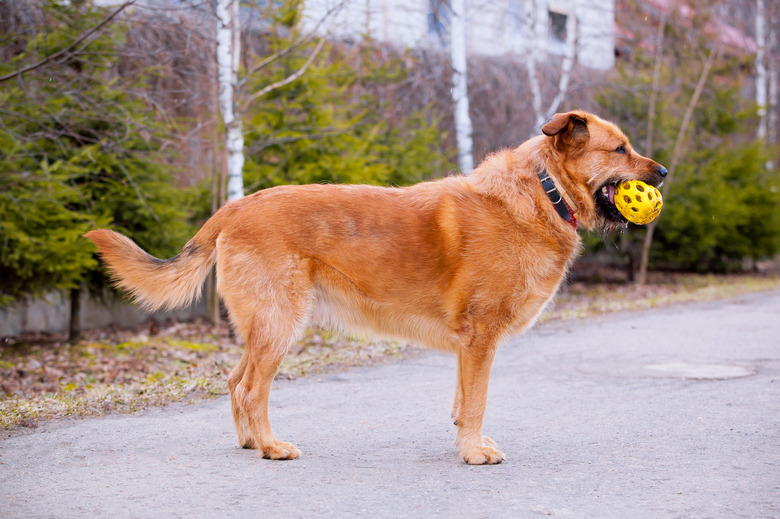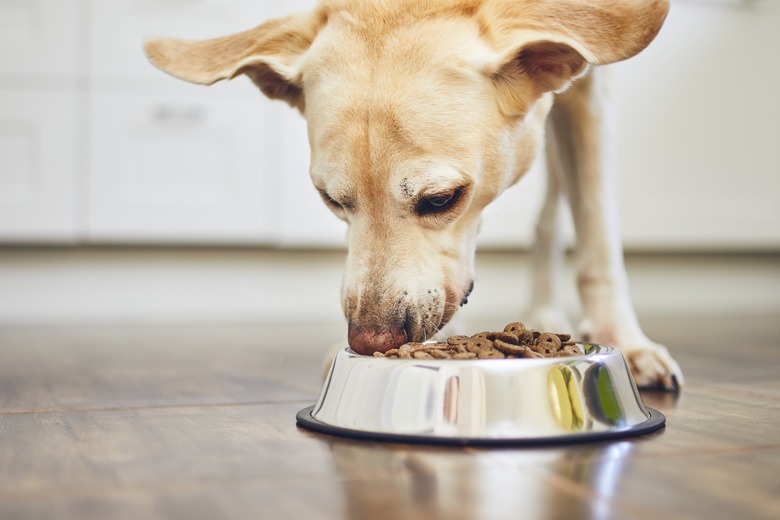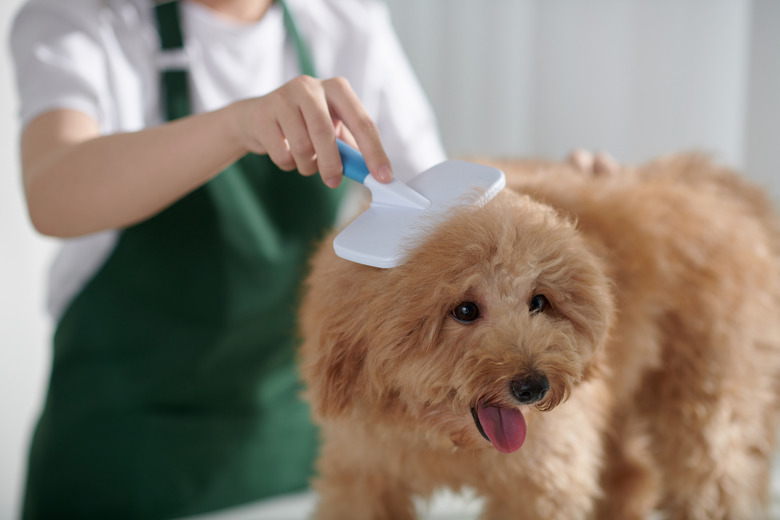Hairball Remedies For Dogs
We may receive a commission on purchases made from links.
Cuteness may earn compensation through affiliate links in this article.
Often, when pet parents think of hairballs, they think of cats, but dogs can get hairballs too. The medical term for hairballs and fur balls is trichobezoar. Hairballs form when a dog ingests hair and then the hair combines with the contents of the stomach over time. Hair cannot be digested by your dog's stomach acid and can cause your dog discomfort, pain, and nausea. Hairball formation happens the same way that a cat hairball does. Long-haired dog breeds can have more of a problem with hairballs.
Symptoms of a dog hairball
Symptoms of a dog hairball
Hairballs can affect dog health. You may see your dog coughing because they are trying to clear their airway. They may be successful in coughing up the hairball right away, or they may be coughing or gagging for a few days in an attempt to get it up.
One of the warning signs is a high-pitched, gagging cough. Retching like this can be indicative of upper airway irritation, infection, or possibly a partial blockage, which can be dangerous. A partial blockage interferes with a dog's ventilation and swallowing. Your dog might experience constipation as well.
Consult your veterinarian to determine the cause of the cough and rule out other potential diseases. The hairball may be bigger than you might expect and is often a loglike shape, resembling the shape of their stool.
Causes of dog hairballs
Causes of dog hairballs
Dogs can get hairballs from grooming and ingesting their own hair that way. While any dog can get hairballs from grooming their own fur, they are more prevalent in dogs who have skin conditions since these dogs are licking their skin more frequently and may swallow more hair than dogs without a skin condition. Dogs may also consume hair, both pet and human, that they find in their home and environment.
Hair contains keratin, a protein that cannot be digested. The hair is often passed through the dog's intestines and comes out in their stool. However, the hair may become entangled on itself or another object in the dog's stomach or intestine and become too large of a mass of hair for the dog to pass in their stool. When this happens, your dog has a hairball.
Importance of preventing hairballs
Importance of preventing hairballs
Prevention is the best medicine when it comes to hairballs. Proper prevention can help keep your pet from feeling sick, experiencing pain, and even undergoing surgery in some cases. Many times hairballs are a result of underlying skin problems, such as allergies. Talk to your veterinarian so that they can determine if an underlying skin condition is at the root of the problem.
If your dog is consuming the hair of another pet, such as another dog or cat, or human hair found on the floor or furniture, you may need to address their exposure to hair. Be sure that your floors are vacuumed and swept frequently and do not have hair on them. Keep trash cans secure so that your dog cannot get into them. You may even want to keep your dog in a designated area of your home or use gates or a crate to help keep the problem under control.
Your veterinarian may also have tips to curb your dog's hair-ingesting habits. Dogs with long fur that needs maintenance could benefit from regular trips to the groomer. This could also help keep the dog fur at bay in your own house or car.
Risk factors for dog hairballs
Risk factors for dog hairballs
Any dog can get a hairball. However, dogs who shed a lot, have longer coats, or suffer from skin conditions or fleas are more likely to develop hairballs. Long-haired breeds tend to be more susceptible to hairballs.
Dogs may lick and chew themselves more than usual due to stress, skin irritation, or itchy skin. The more self-grooming they do, the greater the chance of developing a hairball. Hair stuck in a dog's throat can cause gagging and coughing.
Often, the hairball passes through their digestive system and comes out in their stools. Other times, your dog will vomit them up. But occasionally, the hairball is too large and gets stuck, which is when it can cause a digestive obstruction.
Ways to prevent a dog getting hairballs
Eliminate skin irritations
Check your dog for fleas or ticks, which can be itchy and uncomfortable for them. In addition to scratching themselves to relieve the itching, dogs may bite or lick themselves to soothe their discomfort. However, this makes them unintentionally ingest more fur than they normally would and increases their chances of a large furball getting stuck in their digestive tract.
Administer a monthly flea and tick preventive, such as Onguard Plus Flea & Tick Spot Treatment for Dogs. This is particularly crucial in warm weather when your pet is outdoors more often and has increased exposure to fleas and ticks.
Intestinal parasites could be the culprit. Visit the veterinarian with your dog's stool sample to rule out a parasitic infection, such as giardia. Allergies sometimes cause skin irritation and itchiness, which can lead to your dog licking and chewing the fur around their hind end more than usual.
An overgrowth of yeast and/or bacteria on their skin can cause flaking, itchiness, and irritation. Getting to the root cause of their itchiness can nip licking and the resulting hair ingestion in the bud.
Stop dangerous chewing
Some dog toys, especially stuffed toys, can cause a hairball. The stuffing gets ingested by the dogs when they are chewing on them, either intentionally or by accident. Over time, the stuffing may not get digested or might be too much to pass through their digestive tract.
This can cause a blockage and can mix with fur or grass. Dogs often eat a significant amount of grass if they have an upset stomach. If your dog is prone to hairballs, discontinue using plush toys and only give them toys made of other materials. Some dogs chew on their plush dog beds and ingest some of the pillow stuffing as well. Monitor your pet's behavior to see if these could be possible causes.
Prevent boredom to eliminate stress
If your pet is home alone for substantial periods of time, they may become bored. Some dogs lick themselves a lot when they are bored and ingest more fur. Dogs who are experiencing emotional problems, such as anxiety, separation anxiety, or stress, sometimes lick themselves excessively as a coping mechanism and to self-soothe.
Make sure to leave your dog with plenty of toys to keep them busy and entertained. Give them new toys frequently or rotate toys to keep their interest. Some toys are interactive and designed to stimulate your dog. These toys include interactive food mazes, wobblers, chew toys, treat-dispensing toys, Kongs filled with edible treats, and puzzle balls.
Leaving on a TV or radio may help soothe a dog suffering from separation anxiety. Having a camera or video monitor turned on your pet while you are away may help you monitor your dog's behavior and help them feel more calm and secure while home alone.
Dog pheromones can also help your dog feel more relaxed when home alone. You can plug in multiple dog pheromone diffusers around your home to help alleviate anxiety.
If a dog digests fur and feathers
Some dogs with hunting instincts may eat other animals when outdoors. If they eat the animals whole, they may ingest fur and feathers, which are indigestible. If their digestive system is weak or if the fur and feathers get stuck in their digestive tract, this can be quite dangerous.
If the fur and feathers stay in the digestive tract, they can trap or block decaying feces. This can be dangerous since toxic gases and particles of the rotting substance can be absorbed in the bloodstream. Contact your veterinarian if this is the case. Try to discourage and prevent your dog from ingesting prey animals altogether.
Remedies for dog hairballs
Serve a fiber-rich diet
Adding fiber to your dog's diet can help the hairball move along the digestive tract and help them pass it that way. Fiber supplements can help to move the process along. Fiber supplements and bite-size fiber treats, such as Perfect Poop Digestion & Health Supplement for Dogs or Vetnique Labs Glandex Anal Gland Supplement, can help hairballs while preventing blocked anal glands and other digestive problems.
High-fiber dog foods, such as Iams Minichunks Adult Dry Dog Food, contain high-fiber beet pulp. The low sugar, mildly fermentable fiber helps feed your dog's digestive tract and supplies energy to the digestive tract while providing bulk to keep things moving.
If your dog likes human food, add some fruits and vegetables to their diet. Apples without the core, sweet potatoes, and green beans are all high-fiber, dog-friendly choices. Do not give grapes or raisins, which are toxic for dogs.
Oatmeal can be an effective source of fiber for your dog and a tasty treat. Add the fiber slowly to avoid stomach upset and diarrhea. If your dog starts to develop diarrhea, however, they may be ingesting too much fiber. If this happens, adjust their diet and cut back on their fiber intake.
Pumpkin is another natural and tasty way to help your dog pass a furball. Plain canned pumpkin with no added sugar or spices is a delicious source of fiber. Dogs like the taste, and the fiber can aid in digestion.
Moisturize their skin
Dry skin can cause itchiness in a dog. In cold and dry winter months, make sure to use a moisturizing shampoo, such as CHI Deep Moisture Dog Shampoo. Oatmeal shampoo can also help moisturize a dog's skin.
Using fats and hairball gels
Coconut oil can serve as a natural homemade hairball remedy. Coconut oil aids in digestion and can help eliminate hairballs. Do not give your dog coconut oil if they have a history of pancreatitis. If your dog does not have a history of pancreatitis, you should still use caution with oils and fats. Too much can cause pancreatitis, so talk with your veterinarian before adding any type of fat to your dog's diet.
Your veterinarian may recommend ingestible gel or another solution that will help move along the hairball, such as NaturPet Hairball Care. The ingredients, such as ginger, licorice, cascara sagrada, and dandelion leaf, help break down the hairball and make it easy to pass through their digestive tract.
Brush up on daily care
Give your dog plenty of water to help them stay hydrated, especially if they are vomiting up hairballs. Hydration can help them pass the hairball in their stools faster. Encourage hydration with sodium-free bone broth or a designed-for-dogs electrolyte formula, such as DoggieWater Chicken Flavor Dog Supplement.
Regular grooming is important to get rid of loose hair. When dogs are licking and cleaning themselves, they ingest loose hair. Brush your pet frequently between grooming appointments or use a CHI Dog Grooming Glove to caress your pet during snuggle time.
Let them nibble grass
Some dogs instinctively eat grass on a walk outside if they are feeling nauseous or experiencing stomach discomfort. The grass irritates their stomach further and causes them to vomit. Your dog may do this on their own to try to vomit up the hairball.
You can grow your own grass at home with a kit, and it will not contain any toxic chemicals, pesticides, or insecticides that could make your dog even sicker. If your dog is vomiting for two days and still has not vomited up the hairball, discontinue grass treatment. You do not want your pet to get dehydrated, and they may need a different course of treatment as determined by your veterinarian. And too much grass can cause an intestinal obstruction.
Explore veterinary solutions
Your veterinarian may need to prescribe your dog medication if dietary and natural remedies are not working. You want your pet to pass the hairball as quickly as possible to prevent further discomfort and damage. Medications may include laxatives, and the type and dosage will be determined by your dog's age, breed, and size. Subcutaneous fluids may also be administered.
If no other treatments are effective and the hairball is not successfully vomited up or eliminated, your veterinarian may need to perform surgery. A hairball can block their digestive tract and can be very painful and serious. It may be the only way for your pet to get better.
The bottom line
The bottom line
Hairballs can be a minor pet health irritation, or they can become serious. Many hairballs resolve on their own or with simple behavioral, dietary, or hydration adjustments. However, if your pet is showing signs of distress, contact your veterinarian. Only your veterinarian can determine the proper treatment of a hairball that is causing a blockage. Your veterinarian can alert you to any other health conditions your pet may be suffering from that would cause them to lick their fur excessively in the first place and create hairballs. In some cases, hairballs require immediate medical attention or even surgery, so monitor your pet closely and seek emergency veterinary care if your dog seems dehydrated or in pain.


